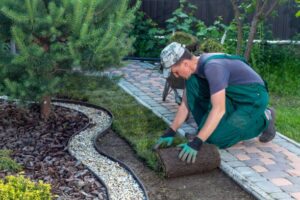Creating a garden that looks magazine-worthy is possible with some simple design tips. The key is knowing what style and purpose you want your garden to serve and how much time you have for maintenance.
It’s also essential to know your property’s peculiarities, including sunny areas, shade, changes in elevation and existing trees and shrubs, and this is what garden design Adelaide is all about.
Decide on a Theme
 A theme helps bring structure to a garden. It can guide what plants you use, the colour of the flowers and what built structures or accents you add, such as trellis ideas, arbours and garden houses. It can also guide the overall feel of your garden; for example, a more formal theme might include straight lines, squared hedges and neatly trimmed plants. A more informal look might include a mix of shapes and sizes or wildflowers.
A theme helps bring structure to a garden. It can guide what plants you use, the colour of the flowers and what built structures or accents you add, such as trellis ideas, arbours and garden houses. It can also guide the overall feel of your garden; for example, a more formal theme might include straight lines, squared hedges and neatly trimmed plants. A more informal look might include a mix of shapes and sizes or wildflowers.
Form themes are a popular option, particularly for small gardens. Themes based on shape can give a cohesive feel and help make the garden feel larger; for instance, if you have a lot of edging, try to keep it consistent. Similarly, if you have many trees and hedging in the garden, try to plant them all together with similar species to create a consistent look.
Mood is another garden theme that can be very effective; for example, a soft pastel or a bold shade might relax or excite you, depending on the effect you’re looking for. You could also consider a texture theme, for example, using a similar range of textures in the plantings and hardscape. A simple way of achieving this is to repeat a specific texture, such as using smooth river rocks throughout the garden, or a specific material, such as wood for the paving or cladding.
Plan Your Space
Garden designers often talk of ‘plant form’, which means examining the overall shape of a plant. If you want a formal look, try precise hedge shapes and neatly trimmed hedging plants, while more informal styles are suited to more naturalistic forms like loose, wild grasses. Also, consider the effect your garden has on microclimates – the areas around buildings or large trees can have different temperature and humidity conditions from the rest of your plot.
Pathways can make the garden feel bigger by directing your eye to different parts of the garden, so they’re an essential feature for any garden design Adelaide. They don’t have to be rigid grids of straight paths, though – instead use curves and winding shapes that will add interest to the scheme as ornamental features in their own right and define edges of beds or borders. Alternatively, structures such as pergolas and obelisks will provide interesting focal points themselves before they’re clothed with climbing plants.
Seating is another must-have for any garden, so plan where you’ll position the furniture – and don’t forget to factor in extras like rugs, chimineas, patio heaters and citronella candles to keep bugs at bay; bee hotels, wildlife ponds, and log piles; or planters for displaying potted shrubs and flowers. You could even try a water bowl, pond or other water to reflect light into the garden.
Think About Light and Temperature
In addition to deciding where to go and what to do, you should consider your garden’s light levels and temperature. For example, if you have south-facing walls, fences or hedges that block out the afternoon sun, you can create an area of shade for growing plants like herbs and vegetables that need cool conditions. Shading also slows the prevailing wind, which is good for young seedlings and hardy crops that don’t like the strong gusts of breezes.
If you can’t put in a permanent shade structure, try using planters, pergolas and obelisks that can be covered with scrambling climbers to give them more character and make them less of an eyesore. They can also highlight areas of the garden where you want to focus attention, for example, the shady edge of a border or a circular pond.
Regarding garden design Adelaide, it’s a great idea to work out different garden areas on a rough ‘bubble’ plan before you start to plant. Think about where you’ll sit for coffee, children’s play areas, practical and storage spaces, veg growing or flower borders, etc.
